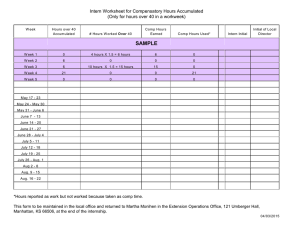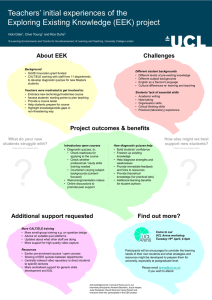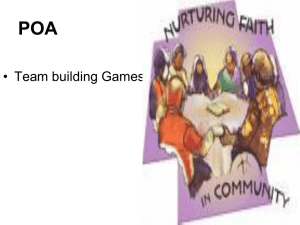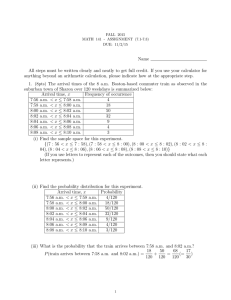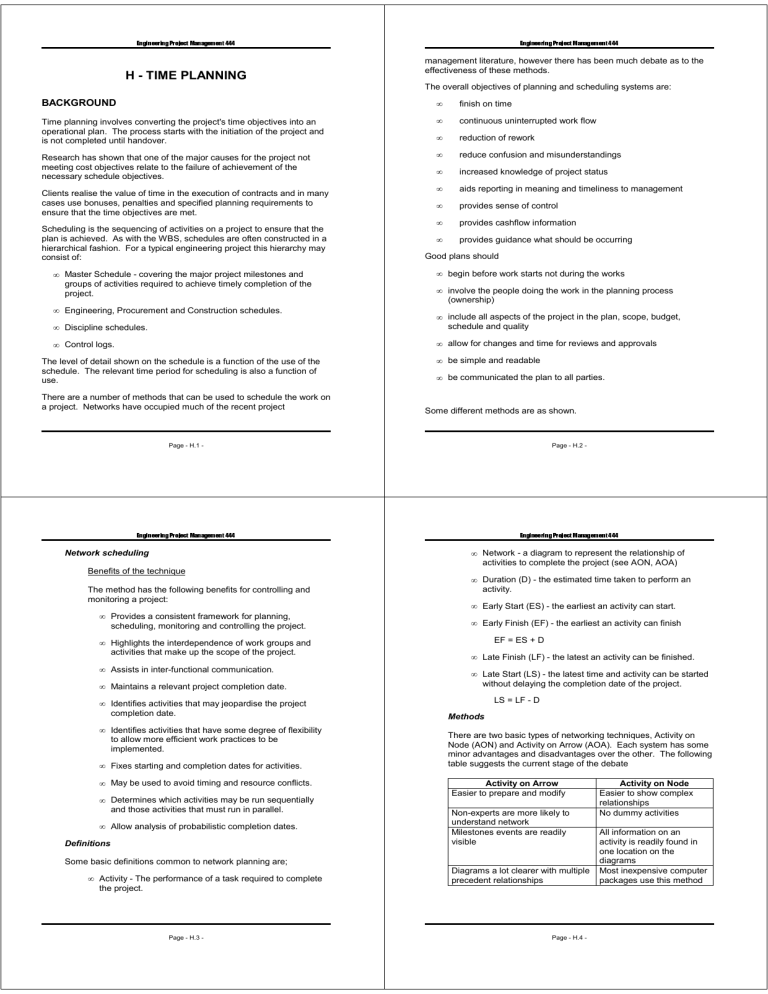
H - TIME PLANNING
management literature, however there has been much debate as to the
effectiveness of these methods.
The overall objectives of planning and scheduling systems are:
BACKGROUND
•
finish on time
Time planning involves converting the project's time objectives into an
operational plan. The process starts with the initiation of the project and
is not completed until handover.
•
continuous uninterrupted work flow
•
reduction of rework
•
reduce confusion and misunderstandings
•
increased knowledge of project status
•
aids reporting in meaning and timeliness to management
•
provides sense of control
•
provides cashflow information
•
provides guidance what should be occurring
Research has shown that one of the major causes for the project not
meeting cost objectives relate to the failure of achievement of the
necessary schedule objectives.
Clients realise the value of time in the execution of contracts and in many
cases use bonuses, penalties and specified planning requirements to
ensure that the time objectives are met.
Scheduling is the sequencing of activities on a project to ensure that the
plan is achieved. As with the WBS, schedules are often constructed in a
hierarchical fashion. For a typical engineering project this hierarchy may
consist of:
• Master Schedule - covering the major project milestones and
groups of activities required to achieve timely completion of the
project.
• Engineering, Procurement and Construction schedules.
Good plans should
• begin before work starts not during the works
• involve the people doing the work in the planning process
(ownership)
• Discipline schedules.
• include all aspects of the project in the plan, scope, budget,
schedule and quality
• Control logs.
• allow for changes and time for reviews and approvals
The level of detail shown on the schedule is a function of the use of the
schedule. The relevant time period for scheduling is also a function of
use.
There are a number of methods that can be used to schedule the work on
a project. Networks have occupied much of the recent project
• be simple and readable
• be communicated the plan to all parties.
Some different methods are as shown.
Page - H.1 -
!
"
"
#
!
$
#
%
&
"
'
(
)
*
*
"
Page - H.2 -
+
"
(
,
,
,
-
.
/
0
.
1
1
2
0
.
/
3
2
4
5
1
6
7
8
9
.
9
/
1
:
1
.
7
;
;
;
• Network - a diagram to represent the relationship of
activities to complete the project (see AON, AOA)
Network scheduling
Benefits of the technique
The method has the following benefits for controlling and
monitoring a project:
• Provides a consistent framework for planning,
scheduling, monitoring and controlling the project.
• Highlights the interdependence of work groups and
activities that make up the scope of the project.
• Assists in inter-functional communication.
• Maintains a relevant project completion date.
• Identifies activities that may jeopardise the project
completion date.
• Identifies activities that have some degree of flexibility
to allow more efficient work practices to be
implemented.
• Fixes starting and completion dates for activities.
• May be used to avoid timing and resource conflicts.
• Determines which activities may be run sequentially
and those activities that must run in parallel.
• Allow analysis of probabilistic completion dates.
Definitions
• Duration (D) - the estimated time taken to perform an
activity.
• Early Start (ES) - the earliest an activity can start.
• Early Finish (EF) - the earliest an activity can finish
EF = ES + D
• Late Finish (LF) - the latest an activity can be finished.
• Late Start (LS) - the latest time and activity can be started
without delaying the completion date of the project.
LS = LF - D
Methods
There are two basic types of networking techniques, Activity on
Node (AON) and Activity on Arrow (AOA). Each system has some
minor advantages and disadvantages over the other. The following
table suggests the current stage of the debate
Activity on Arrow
Easier to prepare and modify
Non-experts are more likely to
understand network
Milestones events are readily
visible
Some basic definitions common to network planning are;
• Activity - The performance of a task required to complete
the project.
Page - H.3 -
Diagrams a lot clearer with multiple
precedent relationships
Page - H.4 -
Activity on Node
Easier to show complex
relationships
No dummy activities
All information on an
activity is readily found in
one location on the
diagrams
Most inexpensive computer
packages use this method
<
=
>
?
=
@
@
A
?
=
>
B
A
C
D
@
E
F
G
H
=
H
>
@
I
@
=
F
J
J
J
K
There seems to be very little real differences to suggest that one
should be used over the other, it is largely a matter of choice. Most
modern programs allow both but are favoured for AON.
WBS Item
AX
A1
A2
BX
B1
B2
CX
C1
C2
C3
C4
C5
C6
C7
To illustrate the method, consider the following:
L
M
N
L
O
O
P
N
L
M
Q
P
R
S
O
T
U
V
W
L
W
M
O
X
O
L
U
Y
Y
Y
Description
Preparatory work
Wake up
Get disrobed
Personal hygiene and Ablutions
Take shower
Arrange hair
Dressing
Put on underwear
Put on pants/skirt
Put on socks
Put on shirt/blouse
Put on tie
Put on shoes
Put on jacket
Time (secs)
0
60
600
350
40
60
45
150
180
100
10
Unless you are unconventional you will possibly adopt the following
sequence:
A1 Wake up, A2 Get undressed, B1 Take a shower, B2 Arrange
hair after shower, C1 Put on underwear or C3 Put on socks or C4
Put on shirt/blouse after shower, C2 Put on pants/skirt after you C1
Underwear on, C6 Put on shoes after pants on and C3 socks on,
C5 put tie on after C4 shirt on, C7 Jacket on after C5 Tie on and B2
arrange hair.
In narrative form this logic is difficult to follow. There are two ways
to describe this logic. Firstly as shown on the following table
\
]
[
^
^
_
]
[
\
`
_
a
b
^
c
d
e
f
[
f
\
^
g
^
[
d
h
h
h
Description
Wake up
Get disrobed
Take shower
Arrange hair
Put on underwear
Put on pants/skirt
Put on socks
Put on shirt/blouse
Put on tie
Put on shoes
Put on jacket
Successors
A2
B1
C1,B2, C4, C3
C7
C2
C6
C6
C5
C7
C7
Get to work
ES
EF
C5 - Put on Tie
Dur 180
Activity
w
w
w
Or as a network diagram as shown over.
s
j
v
r
m
np
o
jk
l
n
m
jm
l
Page - H.7 -
ES
EF
C2 - Put on Pants/skirt
Dur 60
ES
EF
C1 - Put on Underwear
Dur 40
ES
EF
B2 - Arrange Hair
Dur 350.
jk
ES
EF
A2 - Get Disrobed
Dur 60.
i
ES
EF
C7 - Put on Jacket
Dur 10
u
q
ES
EF
C3 - Put on Sox
Dur 45
ES
EF
B1 - Take Shower
Dur 600.
j
s
ES
EF
C6 - Put on Shoes
Dur 100
m
uk
t
Page - H. 8 -
m
ES
EF
A1 - Wake Up
Dur 0.
A1
A2
B1
B2
C1
C2
C3
C4
C5
C6
C7
[
ES
EF
C4 - Put on Shirt/Blouse
Dur 150
Z
Page - H.6 -
8
Page - H.5 -
10
9
1100
1000
900
800
700
600
500
y
|
z
y
400
|
}
Page - H. 1 0 -
Page - H. 9 -
|
~
300
yz
{
}
|
y|
200
¡
¢
£
¤
20
Put on jacket
C7
200
Put on shoes
C6
360
Put on tie
C5
300
90
Put on shirt/blouse
Put on socks
C3
¢
C4
300
240
C2
C1
B2
Put on pants/skirt
Put on underwear
700
200
Arrange hair
Take shower
B1
0
Get disrobed
A2
300
Wake up
A1
Resource
Title
ID
This can be shown as a bar chart as below
yz
100
x
{
¤
¤
¥
§
¨
¦
©
©
ª
¨
¦
§
«
ª
¬
­
©
®
¯
°
±
¦
±
§
©
²
©
¦
¯
³
³
³
TE = (a + 4m + b)/6
Construction and calculations of networks
Network diagrams describe a project in terms of a sequence of
activities and events. An activity is a work task, that is something to
be done.
¦
In normal engineering projects, the first method is usually used due
to experience with the type of work. The second method has a use
when the work is unfamiliar, for example R&D projects.
Float and the critical path.
It is essential to determine what activities are required for the
network. The level of detail required is determined before
construction and the best guide is common sense.
An event represents an instant in time, a major event is usually
termed a milestone.
There are a number of different types of float on a network, the
most common type is total float. Total Float (TF) - the amount of
time an activity can be delayed without delaying the completion of
the project
TF = LF - EF = LS - ES = (LF - ES) - D
To construct the network, the relationships between activities also
need to be known. To determine these relationships for a subject
activity it is essential to:
• Determine what activities are predecessors.
ES
LF
D
• Determine what activities are successors.
• Determine what activities can be done at the same time.
For a network it is only necessary to determine the immediate
successors of an activity. If two activities have a
successor/predecessor relationship, they are termed sequential. If
two or more activities can be performed at the same time they are
parallel.
Calculation of activity times
Activity timing can come from a number of sources. Usually times
are calculated from an estimate of the manhours required to
complete an work item. The hours required are divided by a
notional gang that will undertaken the work. This gives the
duration.
Where probabilistic estimates are taken, the expected time may be
determined from the following formula
Page - H.11 -
Total Slack
If the difference is zero, the activities are deemed to be critical, that
is any change in the duration of the activities will affect the network
completion date as this is the longest path through the network.
The float is in effect the duration that an activity can be increased
before it becomes critical.
In project planning there is much dispute as to who owns the float.
For example a client may suggest a scope change that affects non
critical activities. The debate is to whether the contractor is able to
Page - H.12 -
´
µ
¶
·
µ
¸
¸
¹
·
µ
¶
º
¹
»
¼
¸
½
¾
¿
À
µ
À
¶
¸
Á
¸
µ
¾
Â
Â
Â
Ã
claim a time extension for these changes. Many cases have
investigated this issue, the results are not conclusive, however the
general trends are that the float belongs to the project. Making
judgements on this type of ruling is difficult.
Ä
Å
Æ
Ä
Ç
Ç
È
Æ
Ä
Å
É
È
Ê
Ë
Ç
Ì
Í
Î
Ï
Ä
Ï
Å
Ç
Ð
Ç
Ä
Í
Ñ
Ñ
Ñ
where i = preceding activities.
LF
The total float on a network is often used to determine the tradeoff
between costs and time on a network. The float analysis can be
used to select activities that should be "crashed" at a cost penalty.
LF
Free Float (FF) - the amount of time an activity may be delayed
without delaying the early start times of the immediate following
activity.
D
FFi = ESj min - EFi
Safety
Slack
LF
where i = preceding activity and i = following
activities.
ES
Independent Slack (IS) is the unconditional float on an activity. It is
independent of any other decisions regarding starting times made
elsewhere in the network.
ES
D
ES
IS = max{(ES k min - LF i max -D),0}
Free Slack
ES
Safety Slack (SS) - the amount of time you can delay an activity
given that all preceding activities have been delayed.
SS = LF - LFi max
Page - H.13 -
Ó
Ô
Õ
Ó
Ö
Ö
×
Õ
Ó
Ô
Ø
×
Ù
Ú
Ö
Û
Ü
Ý
Þ
Ó
Þ
Ô
Ö
ß
Ö
Ó
Ü
à
à
à
H o lid a y
Ò
Page - H.14 -
LF
200
190
180
D
LF
Independent
Slack
T a rg e t F in ish
ES
ES
170
160
150
140
130
ï
ï
120
ï
ë
â
î
å
íã
â
100
ì
í
ë
å
æè
ç
Line of Balance
âã
ä
æ
å
A number of other methods exist. Of these, the Line of
Balance is particularly useful for repetitive projects. These
type of projects include roadworks, transmission lines and
pipelines. The method comes from production line
scheduling.
ä
âå
á
âã
90
80
70
60
50
40
The Line of Balance looks at methods to achieve an output by
crew sizes, equipment and other techniques that will match
the schedule time objectives.
30
20
Page - H.15 T im e
W eek 1
W eek 2
W eek 3
W eek 4
W eek 5
W eek 6
W eek 7
W eek 8
W eek 9
W eek 10
W eek 11
W eek 12
W eek 13
W eek 14
W eek 15
10
S ta g e
é
D if ic u lt W o rk
ê
Other time planning methods
Page - E.16 -
110
å
Pre-shutdown
Shutdown
Post Shutdown
2 weeks
Less than 10 hours
1 month
2 months
1 to 5 days
1 month
6 months
6 to 30 days
1 month
ô
ñ
ü
ø
ö
ú
ù
ô
õ÷
ñò
ñô
ñò
ÿ
õ
ô
Page - E.18 -
Monitor Progress Ensure
Daily against
resources
work sheets
properly utilized
Schedule Scope
Changes
Forecast
completion
Identify changes
to planned scope
Determine if
scope change is
necessary
If forecast
completion is
overrun- revisit
costs and
necessity
ý
Shutdown
ñ
Resourcing
Determine
manning for all
disciplines
Determine Tools
and Equipment
required
Detail
Manufactured
Items
ú
Scheduling
Develop work
packs for each
item
Determine
maximum time
frame for
shutdown
þ
Planning
Identify
equipment to be
serviced
Determine Work
Detail
Estimate time for
each item
Identify Critical
Path(s)
ô
Page - E.17 -
þ
Phase
Pre-Shutdown
See AON Solver Spreadsheet.
üò
Page - E.19 -
1 month
10 hours to one day
1 month
Duration of Phase in relation to Shutdown
Close out costs
ð
Three stages and durations shown below
Phase
Close out all
contracts
Demobilize
labour
ó
Monitor schedule Determine any
and correct
losses of tools or
sequencing of
equipment
work
ó
Recommissionin
g sequence for
each item
û
Post-Shutdown
þ
Costing
Direct labour
Indirect labour
Tool hire
Equipment Hire
Manufactured
items
Consumables
Travel Expenses
Meals and
Accommodation
Contingency
Allowances
Ensure all
Collect and log
controls are
all costs on a
being maintained daily basis
Timesheets
prepared and
checked for
labour and
Equipment
Organization
Ormganize
mobilization,
Accommodation
and meals
Tools and
Equipment Hire
Tender for offsite
manufacture
